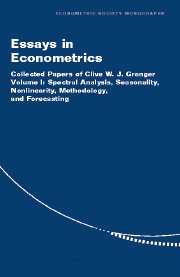Book contents
- Frontmatter
- Contents
- Acknowledgments
- List of Contributors
- Introduction
- 1 The ET Interview: Professor Clive Granger
- PART ONE SPECTRAL ANALYSIS
- PART TWO SEASONALITY
- PART THREE NONLINEARITY
- 6 Non-Linear Time Series Modeling
- 7 Using the Correlation Exponent to Decide Whether an Economic Series is Chaotic
- 8 Testing for Neglected Nonlinearity in Time Series Models: A Comparison of Neural Network Methods and Alternative Tests
- 9 Modeling Nonlinear Relationships Between Extended-Memory Variables
- 10 Semiparametric Estimates of the Relation Between Weather and Electricity Sales
- PART FOUR METHODOLOGY
- PART FIVE FORECASTING
- Index
7 - Using the Correlation Exponent to Decide Whether an Economic Series is Chaotic
Published online by Cambridge University Press: 06 July 2010
- Frontmatter
- Contents
- Acknowledgments
- List of Contributors
- Introduction
- 1 The ET Interview: Professor Clive Granger
- PART ONE SPECTRAL ANALYSIS
- PART TWO SEASONALITY
- PART THREE NONLINEARITY
- 6 Non-Linear Time Series Modeling
- 7 Using the Correlation Exponent to Decide Whether an Economic Series is Chaotic
- 8 Testing for Neglected Nonlinearity in Time Series Models: A Comparison of Neural Network Methods and Alternative Tests
- 9 Modeling Nonlinear Relationships Between Extended-Memory Variables
- 10 Semiparametric Estimates of the Relation Between Weather and Electricity Sales
- PART FOUR METHODOLOGY
- PART FIVE FORECASTING
- Index
Summary
‘In Roman mythology, the god Chaos is the father of the god Time’
Robert Graves, I Claudius – Arthur Barker, London, 1934Summary
We consider two ways of distinguishing deterministic time-series from stochastic white noise; the Grassberger–Procaccia correlation exponent test and the Brock, Dechert, Scheinkman (or BDS) test. Using simulated data to test the power of these tests, the correlation exponent test can distinguish white noise from chaos. It cannot distinguish white noise from chaos mixed with a small amount of white noise. With i.i.d. as the null, the BDS correctly rejects the null when the data are deterministic chaos. Although the BDS test may also reject the null even when the data are stochastic, it may be useful in distinguishing between linear and nonlinear stochastic processes.
INTRODUCTION
Econometricians and applied economists often take the viewpoint that unforecastable shocks and innovations continually bombard the actual economy. In other words, the economy is essentially stochastic in nature. By contrast, some models in the economic theory literature (e.g. Grandmont, 1985) suggest that an essential nonlinearity in real economic forces permits deterministic time-series to have the appearance of chaos. It is our purpose here to examine some of the tests that have been proposed to resolve the issue. The choice is whether the economy is better modelled as (1) essentially linear in structure with significant stochastic elements, or (2) having a nonlinear structure with insignificant stochastic forces or (3) having a clear nonlinear structure but with significant stochastic shocks.
- Type
- Chapter
- Information
- Essays in EconometricsCollected Papers of Clive W. J. Granger, pp. 188 - 207Publisher: Cambridge University PressPrint publication year: 2001



